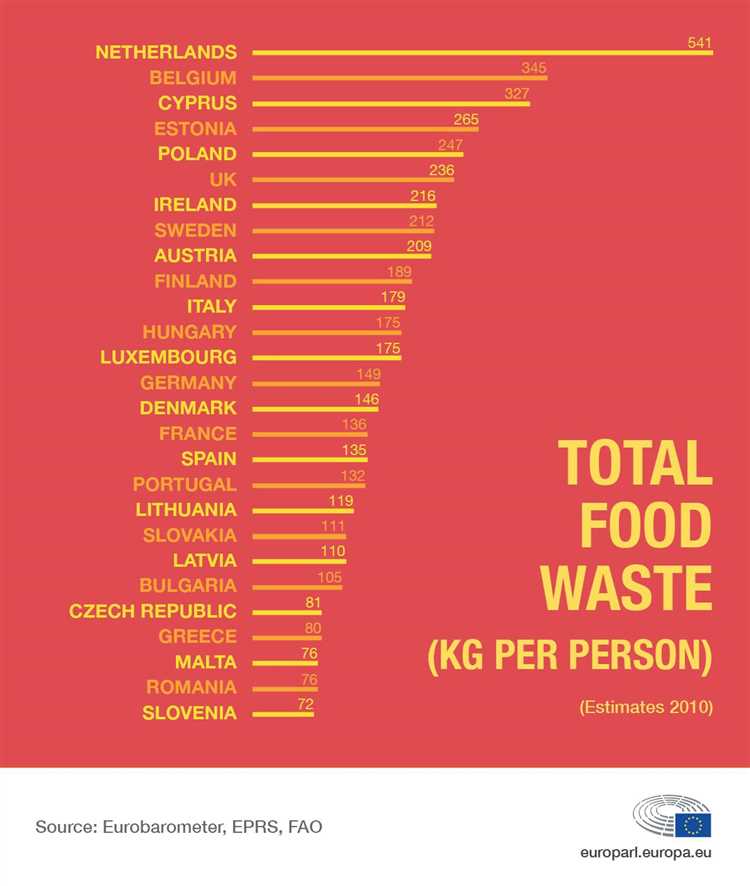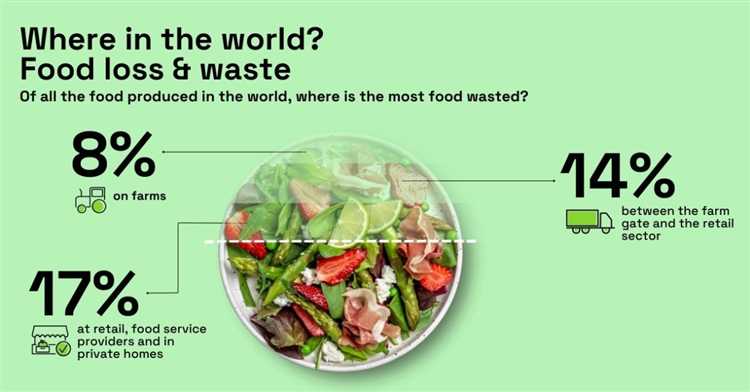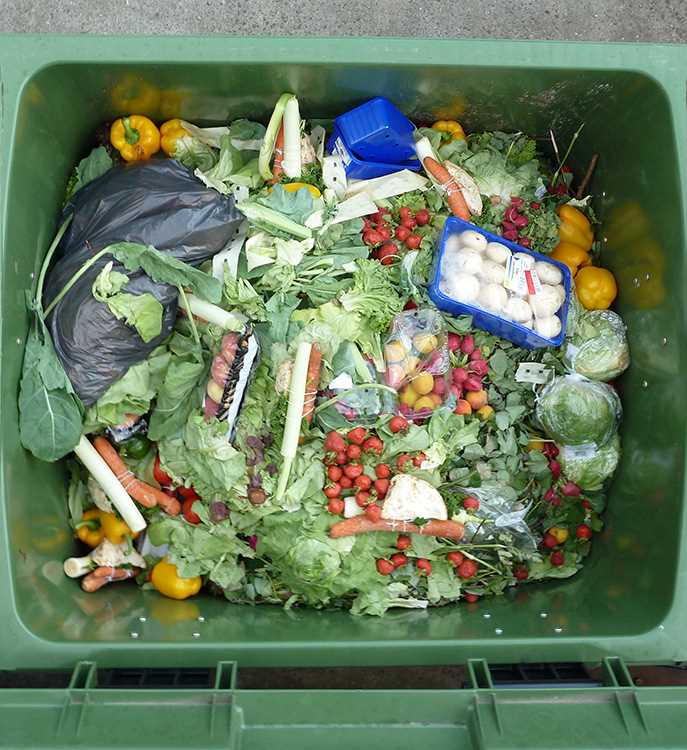
Food waste is a global issue that has serious environmental, social, and economic impacts. It is estimated that around one-third of all food produced in the world is lost or wasted. While the problem of food waste exists in every country, some nations are considered major offenders.
One of the countries that stands out in terms of food waste is the United States. With a highly developed agricultural industry and a culture of abundance, Americans waste a staggering amount of food. It is estimated that around 40% of the food produced in the United States goes uneaten and ends up in landfills. This not only has a negative impact on the environment but also represents a significant loss of resources.
Another country that struggles with food waste is China. As one of the most populous countries in the world, China faces the challenge of feeding its large population. However, a considerable amount of the food produced in China goes to waste. According to some estimates, China wastes up to 17-18% of its total food production. This is particularly concerning given the high number of people suffering from hunger in certain regions of the country.
- Global Food Waste Problem
- Social Implications
- Economic Implications
- Environmental Implications
- Factors Contributing to Food Waste
- 1. Overproduction
- 2. Consumer Behavior
- Impact of Food Waste on the Environment
- 1. Greenhouse Gas Emissions
- 2. Water Usage
- 3. Land Use
- Efforts to Reduce Food Waste
- Country-wise Comparison of Food Waste
- United States
- China
- Q&A:
- Which country wastes the most food?
- What are the main reasons for food waste in the United States?
- How does food waste in the United States impact the environment?
- What measures can be taken to reduce food waste in the United States?
Global Food Waste Problem
Food waste is a global problem that has significant social, economic, and environmental implications. Every year, an astonishing amount of food is wasted around the world, contributing to hunger, poverty, and climate change.
Social Implications

Food waste exacerbates hunger and malnutrition, which affects millions of people worldwide. While more than enough food is produced to feed everyone on the planet, a significant portion goes to waste. This perpetuates cycles of poverty and inequality, as those in need are unable to access the food they require for their well-being.
In addition, food waste can have negative effects on public health. Rotting and discarded food can attract pests and vermin, leading to the spread of diseases. It can also contaminate water sources and pollute the environment, further endangering human health.
Economic Implications
Economically, food waste represents a tremendous loss of resources. The production, processing, packaging, and transportation of food require huge amounts of energy, water, and labor. When food is wasted, all these resources are wasted as well. This not only strains the global food supply chain but also leads to significant economic losses for farmers, manufacturers, and distributors.
Furthermore, the disposal of food waste also incurs additional costs for waste management. Governments and municipalities spend large sums of money on collection, transportation, and disposal of food waste, adding a burden to already stretched public budgets.
Environmental Implications
Food waste has a severe impact on the environment. The production of food requires vast amounts of land, water, and energy. When food is wasted, all these resources are also wasted, contributing to deforestation, water scarcity, and climate change.
Decomposing food waste in landfills generates methane, a potent greenhouse gas that contributes to climate change. Additionally, the production and distribution of food contribute to greenhouse gas emissions through the use of fossil fuels. By reducing food waste, we can lower greenhouse gas emissions, conserve natural resources, and mitigate the effects of climate change.
In conclusion, the global food waste problem has vast social, economic, and environmental consequences. Addressing this issue requires a combined effort from governments, businesses, communities, and individuals. By implementing sustainable practices, reducing food waste, and improving food distribution methods, we can help alleviate hunger, reduce economic losses, and protect the planet for future generations.
Factors Contributing to Food Waste
Food waste is a complex issue with multiple factors contributing to its occurrence. These factors can vary from country to country and region to region depending on various socio-economic, cultural, and environmental factors. Below are some common factors that contribute to food waste:
1. Overproduction
One of the main factors contributing to food waste is overproduction. Food production systems often produce more food than what is needed or consumed. This can be due to various reasons such as food industry standards, market demand fluctuations, and agricultural practices that prioritize high yields. As a result, a significant amount of food ends up wasted.
2. Consumer Behavior
Consumer behavior also plays a crucial role in food waste. Consumers often buy more food than they actually need, leading to food spoilage and waste. This can be attributed to factors such as bulk purchasing, lack of awareness about portion sizes, and impulsive buying habits. Additionally, consumer confusion regarding expiration dates and food storage practices also contributes to food waste.
| Factors Contributing to Food Waste | Examples |
|---|---|
| Overproduction | Excess food produced due to market demand fluctuations |
| Consumer Behavior | Impulsive buying habits and lack of awareness about portion sizes |
These are just a few examples of the factors contributing to food waste. It is important to address these factors at various levels, including production, distribution, retail, and consumer levels, in order to reduce food waste and promote a more sustainable food system.
Impact of Food Waste on the Environment
Food waste is a global problem that has significant negative impacts on the environment. When food is wasted, it is not only a waste of resources, but it also contributes to various environmental issues.
1. Greenhouse Gas Emissions
One of the main consequences of food waste is the production of greenhouse gas emissions. When food decomposes in landfills, it produces methane, a potent greenhouse gas that contributes to climate change. According to the United Nations Food and Agriculture Organization (FAO), if food waste was a country, it would be the third-largest emitter of greenhouse gases after China and the United States.
2. Water Usage
Producing food requires a significant amount of water. When food is wasted, all the water that was used to grow, process, and transport that food is also wasted. In a world where water scarcity is becoming a growing concern, reducing food waste is crucial to conserving this valuable resource.
Furthermore, water pollution is also a consequence of food waste. When wasted food ends up in landfills, it can contaminate groundwater and nearby water bodies through the leachate produced during decomposition.
Reducing food waste not only helps to conserve water resources but also reduces the impact on water pollution.
3. Land Use
Food waste also leads to unnecessary land use. To produce food that ultimately goes to waste, vast amounts of land are dedicated to agriculture. By reducing food waste, we can minimize the need for expanded agricultural land, which in turn helps to preserve natural habitats, reduce deforestation, and protect biodiversity.
Food waste has a significant impact on the environment. To combat this issue, it is vital to raise awareness about the consequences of food waste and take collective action to reduce waste throughout the entire food supply chain, from production to consumption.
Efforts to Reduce Food Waste
Various countries and organizations around the world have recognized the importance of reducing food waste and have implemented initiatives to address this issue. These efforts aim to not only reduce the environmental impact of food waste but also alleviate hunger and improve food security.
One approach to reducing food waste is through educational campaigns and public awareness. By educating individuals about the consequences of food waste and providing tips on how to reduce it, people can make more informed choices about their consumption and disposal habits.
Another effort is to improve food storage and transportation infrastructure. Proper storage facilities and transportation systems help to minimize food spoilage and ensure that perishable items reach consumers in a timely manner. This can help reduce the amount of food that is wasted due to inadequate storage conditions or logistical challenges.
Furthermore, many organizations have implemented food donation programs. These initiatives aim to redirect surplus food from restaurants, grocery stores, and other food establishments to those in need. By facilitating the donation of excess food, these programs not only reduce waste but also provide valuable resources to communities facing food insecurity.
Some countries have also implemented policies and regulations to reduce food waste at various stages of the food supply chain. These policies may include measures such as encouraging food businesses to measure and monitor their waste, implementing incentives for food waste reduction, or enforcing regulations to prevent the disposal of edible food.
Additionally, innovative technologies are being developed to address food waste. For example, some companies are creating apps and online platforms that connect consumers with discounted or surplus food from local retailers, reducing the amount of food that goes to waste.
In conclusion, efforts to reduce food waste are underway globally. Through educational campaigns, infrastructure improvements, food donation programs, policy implementations, and technological advancements, countries and organizations are working towards a more sustainable and equitable future where food waste is minimized.
Country-wise Comparison of Food Waste
Food waste is a global issue that has significant economic, environmental, and social impacts. While many countries struggle with food waste, some countries stand out as leaders in reducing and managing this issue. This section will compare the food waste statistics of several countries to shed light on the problematic areas and highlight the nations that have made significant progress.
United States

The United States is known for its high levels of food waste. According to the U.S. Environmental Protection Agency (EPA), approximately 30 to 40 percent of the food supply in the United States goes to waste. This is equivalent to around 133 billion pounds of food wasted annually. The main reasons for food waste in the United States include consumer behavior, food industry practices, and inadequate infrastructure for handling surplus food.
China
China is the world’s largest producer of food, but it also faces significant challenges in managing food waste. The country’s rapid economic growth and changing dietary patterns have led to increased food waste. According to data from the Chinese Academy of Sciences, China wastes around 35 million tons of food every year, which accounts for about one-third of its total annual food production. The Chinese government has implemented various measures to reduce food waste, including campaigns to raise awareness and improve food management practices.
Please note that the data provided here may vary depending on the sources and methods used for measuring food waste. Additionally, food waste patterns can fluctuate over time due to various factors such as economic conditions, cultural practices, and government policies.
In conclusion, food waste is a critical issue affecting countries around the world. While specific numbers may vary, it is evident that food waste is a significant problem that requires immediate attention. Efforts to reduce food waste should be prioritized at both the individual and national levels to ensure a more sustainable future for all.
Q&A:
Which country wastes the most food?
The United States wastes the most food among all countries. Approximately 40% of the food produced in the United States goes uneaten.
What are the main reasons for food waste in the United States?
There are several main reasons for food waste in the United States. Firstly, consumers often buy more food than they need and end up throwing away the excess. Secondly, the food industry and retailers often reject food that does not meet certain visual or quality standards. Lastly, restaurants and food service providers also contribute to food waste by throwing away unconsumed leftovers.
How does food waste in the United States impact the environment?
Food waste in the United States has a significant impact on the environment. When food is wasted, all the resources used to produce, transport, and process that food are also wasted, including water, energy, and land. Additionally, decomposing food waste in landfills produces methane gas, a potent greenhouse gas that contributes to climate change.
What measures can be taken to reduce food waste in the United States?
There are several measures that can be taken to reduce food waste in the United States. Firstly, consumers can plan their meals and purchase only the amount of food they need. Secondly, food companies and retailers can donate surplus food to food banks and other charitable organizations. Lastly, policymakers can implement regulations to encourage and incentivize food waste reduction throughout the food supply chain.